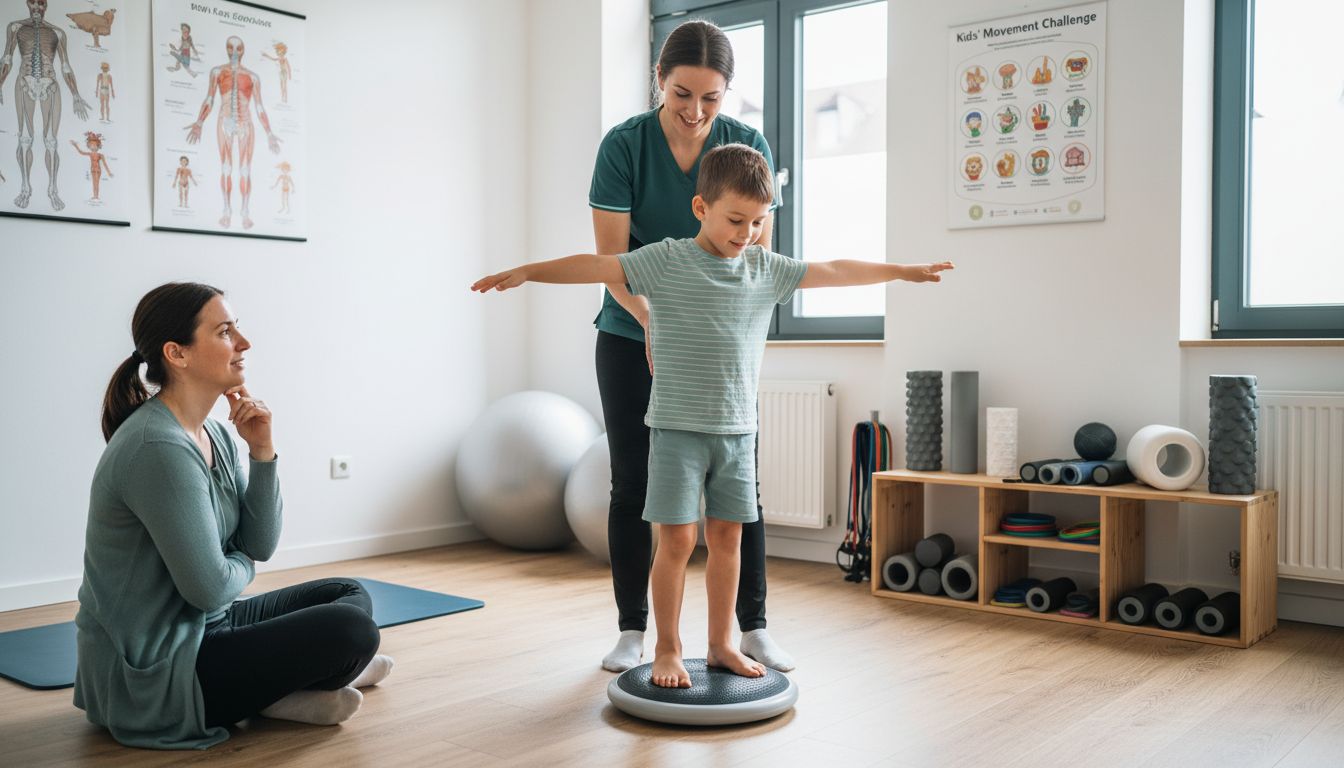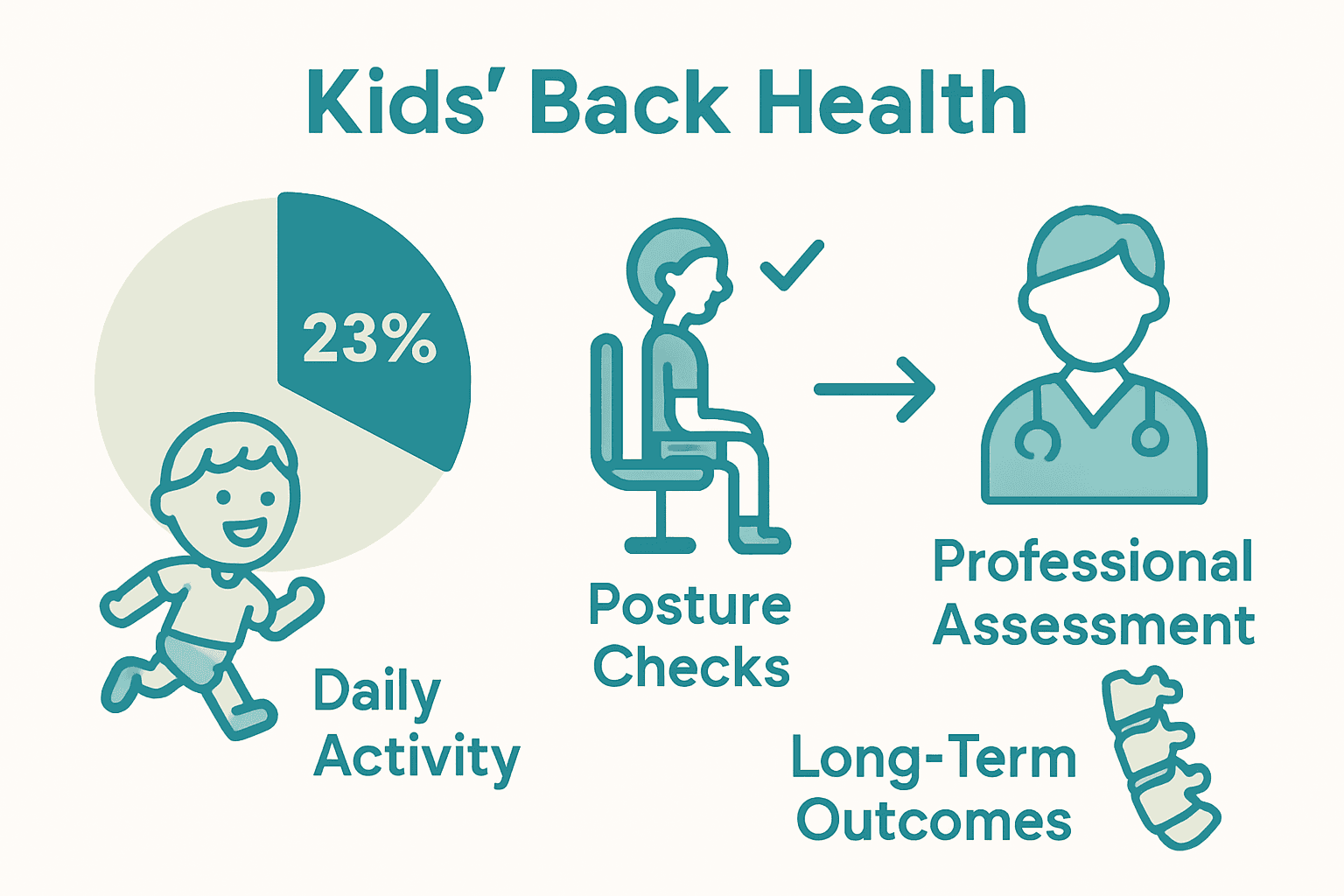Expert Guide to Kids’ Back Health for Active Families
- Dr Nathan Bridger

- 13 hours ago
- 7 min read

Over 75 percent of Australian children are missing out on the recommended daily movement for healthy growth. As kids spend more time sitting, using devices, or skipping active play, their posture and back health can start to suffer without anyone noticing. Learning how to support your child’s growing body is about more than just staying active. This guide offers parents practical, step-by-step tips to keep children’s backs strong and prevent problems before they begin.
Table of Contents
Quick Summary
Key Point | Explanation |
1. Track daily habits and movements | Log your child’s activities to understand their health, focusing on movement, screen time, and posture. |
2. Implement a back care routine | Establish morning and evening stretches to promote flexibility and body alignment for better musculoskeletal health. |
3. Include strength and flexibility activities | Engage children in fun exercises like animal movements and yoga to build strength and improve flexibility. |
4. Promote injury prevention strategies | Teach warm-up routines, hydration, and body awareness to help children safely participate in sports and activities. |
5. Regularly assess physical development | Perform weekly checks on your child’s posture and movement to track progress and address any issues early. |
Step 1: Assess Daily Habits and Movement Patterns
Tracking your child’s daily habits is crucial for understanding their overall health and movement patterns. According to NSW Health, children aged 5 to 17 should engage in at least one hour of moderate to vigorous physical activity daily.
To start assessing your child’s habits, grab a notebook or use a digital tracking app to log their daily activities. Look closely at key areas like physical movement, screen time, sleep patterns, and posture. Pay special attention to how long they sit during study or play times and observe their body positioning when using devices or doing homework.
A helpful tip is creating a simple daily log where you track activity levels, sitting duration, and movement quality. Look for patterns such as prolonged sitting, uneven shoulder positioning, or consistent neck tilting during device use. By understanding these subtle movement habits early, you can proactively support your child’s musculoskeletal health and prevent potential long term postural challenges.
Step 2: Set Up a Kid-Friendly Back Care Routine
Creating a supportive back care routine for your children is essential for their long term musculoskeletal health. According to the Australian Government Health Guidelines, children aged 5 to 17 should integrate activities that strengthen muscles and bones at least three days per week.
Start by establishing a morning and evening stretching ritual that makes movement fun and engaging. Incorporate gentle spine mobility exercises like cat cow stretches, child pose, and light twists that can be done together as a family. Aim to create a consistent 10 to 15 minute routine that focuses on flexibility, core strength, and proper body alignment.
A helpful strategy is turning these exercises into a playful game or challenge. You might create a sticker chart to track daily movement goals or use storytelling to make stretches more interesting. When children associate back care with positive experiences, they are more likely to maintain these healthy habits.

For additional insights, check out our guide on chiropractic tips for parents to support your family’s wellness journey.
Step 3: Incorporate Strength and Flexibility Activities
Building a comprehensive back health routine for kids means creating engaging activities that support muscular strength and flexibility. Queensland Health recommends that children aged 6 to 17 should accumulate at least one hour of moderate to vigorous intensity activity daily, including muscle and bone strengthening exercises at least three days per week.
Start by introducing fun bodyweight exercises that kids will enjoy. Consider animal movement games like bear crawls, crab walks, and frog jumps that naturally engage core muscles and improve overall body strength. Yoga inspired poses such as plank, downward dog, and warrior positions can help develop core stability while making exercise feel like play. Focus on creating short 10 to 15 minute sessions that mix dynamic movements with gentle stretching.
A helpful tip is making these activities a family challenge or game. You might create a weekly movement bingo card with different strength and flexibility exercises that everyone can participate in together. By treating back care as an enjoyable shared experience, you will help your children develop lifelong healthy habits. Our 7 Benefits of Chiropractic for Kids guide offers additional insights into supporting your child’s musculoskeletal development.
Step 4: Promote Injury Prevention During Play and Sport
Helping your children stay safe during physical activities requires proactive strategies and ongoing education. According to the Raising Children Network, injury prevention starts with ensuring children engage in activities appropriate for their physical capabilities and use proper safety gear.
Establish a consistent pre and post activity routine that includes comprehensive warm up and cool down exercises. Teach your children the importance of gentle stretching, proper hydration, and listening to their body signals. Focus on helping them understand the difference between normal muscle fatigue and potential injury warning signs. Demonstrate basic stretching techniques together and make the process interactive and fun by turning warm ups into playful movement challenges.
A critical strategy is staying actively involved in your child’s sporting activities. The Sydney Children’s Hospitals Network recommends parents remain engaged to ensure proper technique and safety. For comprehensive guidance on supporting your child’s athletic journey, explore our sports injury prevention tips to develop a holistic approach to your child’s physical wellbeing.
Step 5: Confirm Healthy Progress With Quick Checks
Tracking your child’s physical development and movement patterns requires consistent and thoughtful observation. The Sydney Children’s Hospitals Network highlights that only 23% of children aged 5 to 14 currently meet recommended daily activity levels, making regular progress checks crucial.
Develop a simple weekly assessment routine that tracks key indicators of your child’s back health and overall movement. This could include observing their posture during daily activities, checking their comfort during play, and monitoring their flexibility and strength. Create a visual tracking chart where you can note improvements in things like range of motion, comfort during activities, and energy levels. Pay attention to subtle changes such as how easily they move, any complaints of discomfort, or shifts in their physical capabilities.

A practical tip is scheduling quarterly professional assessments with a chiropractor who specialises in paediatric care. These check-ups can provide professional insights into your child’s musculoskeletal development. For a deeper understanding of maintaining your child’s physical wellness, review our chiropractors injury prevention guide to complement your home monitoring efforts.
Support Your Child’s Back Health with Expert Care
Every active family wants their kids to thrive with strong backs and healthy movement patterns. This guide emphasises the importance of daily assessment, kid-friendly back care routines, strength building, injury prevention, and regular progress checks—all vital steps to prevent long-term postural issues and keep children confidently active. But knowing what to do is just the start—turning those insights into lasting habits can be challenging without professional support.
At North Fremantle Chiropractic, we help families like yours build resilience beyond pain by combining hands-on chiropractic care with sport-focused strength principles. With tailored programs designed to empower your child’s musculoskeletal development, we make back care a positive and enjoyable part of their lifestyle. Whether it is establishing safe movement routines or preventing sports injuries, our team provides the expertise that every parent needs.

Ready to give your child the back health advantage that lasts a lifetime? Visit North Fremantle Chiropractic today to book a family consultation. Discover how our chiropractic tips for parents and sports injury prevention advice can help your kids move, feel and perform better now and into the future.
Frequently Asked Questions
How can I assess my child’s daily movement patterns?
Tracking your child’s daily movement involves noting their physical activities, screen time, and sitting duration. Start by creating a simple daily log to observe and analyse these habits over a week to identify patterns and areas for improvement.
What should a kid-friendly back care routine include?
A kid-friendly back care routine should consist of enjoyable stretching and strength-building exercises done at least three times a week. Create a morning or evening ritual with fun activities, such as family stretches or playful movements, lasting about 10-15 minutes.
How can I promote injury prevention during my child’s sports activities?
Promote injury prevention by establishing a routine that includes warm-up and cool-down exercises before and after sports activities. Teach your child the importance of stretching, staying hydrated, and recognising the difference between normal fatigue and pain, and practice these routines together to make it interactive.
What are effective strength and flexibility activities for kids?
Effective strength and flexibility activities for kids include bodyweight exercises such as bear crawls, crab walks, and yoga poses like plank and downward dog. Aim to incorporate these activities into short sessions of 10-15 minutes to make them fun and engaging, perhaps through family challenges or games.
How can I confirm my child’s progress in back health?
Confirm your child’s progress by conducting regular weekly assessments of their posture, flexibility, and comfort during activities. Create a visual tracking chart to note improvements, allowing you and your child to see their advancements clearly over time.
When should I seek professional assessments for my child’s back health?
Schedule professional assessments for your child at least quarterly to check on their musculoskeletal development. Utilise these check-ups to gain insights and ensure that your child’s back health is progressing positively, enhancing their overall physical well-being.
Recommended

Comments